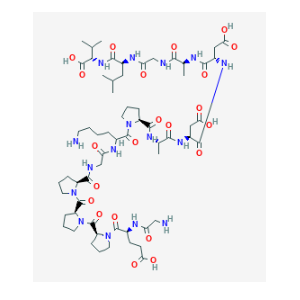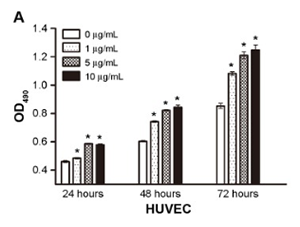











Product Usage: This PRODUCT IS INTENDED AS A RESEARCH CHEMICAL ONLY. This designation allows the use of research chemicals strictly for in vitro testing and laboratory experimentation only. All product information available on this website is for educational purposes only. Bodily introduction of any kind into humans or animals is strictly forbidden by law. This product should only be handled by licensed, qualified professionals. This product is not a drug, food, or cosmetic and may not be misbranded, misused or mislabled as a drug, food or cosmetic.
BPC-157, short for Body Protection Compound-157, is a derivative of body protection compound (BPC). BPC is a protein found naturally in the human digestive tract. It plays a significant role in protecting the lining of the gastrointestinal tract from damage, promoting healing, and encouraging blood vessel growth.
Synthetic BPC-157, a pentadecapeptide comprising 15 amino acids isolated from the much larger BPC protein, has been found to retain many of the healing properties of its parent molecule. In particular, BPC-157 has been shown to have effects on:

Source: PubChem
Sequence: Gly- Glu-Pro-Pro-Pro-Gly-Lys-Pro-Ala-Asp-Asp-Ala-Gly-Leu-Val
Molecular Formula: C62H98N15O22
Molecular Weight: 1419.556 g/mol
PubChem CID: 108101
The natural function of BPC in the GI tract is to maintain the integrity of the mucosal barrier that protects underlying tissues from the harmful actions of gastric acid, bile, and other compounds necessary for digestion and absorption of nutrients from food. At least part of this function is mediated through the recruitment of fibroblasts. BPC-157 has a dose-dependent effect on the spread of fibroblasts in culture and in vivo, causing the cells to both proliferate and migrate faster[1]. Fibroblasts are integral to wound healing as they are the cells responsible for laying down extracellular matrix proteins like collagen, fibrin, elastin, and more.
BPC-157 is a potent angiogenic factor, increasing the rate at which endothelial cells (the cells that line blood vessels) proliferate and grow[1]–[3]. Research in rats shows that the peptide substantially increases the rate of collateral blood vessel growth in the setting of ischemia[4]. While this effect has been primarily observed in the GI tract, there is evidence for similar benefit in cardiovascular, neurological, and muscle tissues, suggesting that BPC-157 may be used as both a therapy in the setting of stroke and heart attack as well as a probative peptide for understanding how to promote healing following ischemic injury[5], [6]. Studies in chicken embryos suggest that at least part of the mechanism by which BPC-157 promotes vascular growth is through the stimulation of VEGFR2, a cell surface receptor active in the nitric oxide signaling pathway[4], [7], [8]. VEGFR2 is thought to play an important role in endothelial cell growth, proliferation, and longevity.

BPC-157 concentration versus vascular endothelial cell growth
Source: PubMed
Cell culture research has effectively demonstrated vascular “running” secondary to BPC-157 administration. Vascular running is the process by which vessels grow toward an area of injury or around an area of vascular occlusion to reestablish blood flow to distal tissue and protect cell function[9]. This particular function of BPC-157 may make it possible to develop an effective oral treatment for slow-growing arterial occlusions, such as are seen in atherosclerotic heart disease. This area of research may one day render unnecessary surgical interventions such as stenting, coronary artery bypass grafting, and more.
Given its roles in fibroblast recruitment and blood vessel growth, it should come as no surprise that BPC-157 has shown positive findings in animal models of tendon, ligament, bone, and other connective tissue injuries. Tendon and ligament injuries are slow to heal, in large part, due to poor blood supply in these tissues. Poor blood supply slows the rate at which fibroblasts and other wound-healing cells can reach the area of injury and, ultimately, restricts the overall level of repair that can take place. Both in vitro and in vivo research involving rat tendons has shown that BPC-157 promotes collateralization and boosts fibroblast density in the setting of tendon, ligament, and bone injury. This research indicates that BPC-157 is more effective than bFGF, EFG, and VGF hormones in promoting healing in these tissues[10].
Experiments using FITC-phalloidin staining have revealed that BPC-157 is a potent stimulator of F-actin formation in fibroblasts[11]. F-actin is critical to cell structure and function, playing an important role in cell migration. Analysis via western blotting indicates that BPC-157 increases phosphorylation of paxillin and FAK proteins, which are critical proteins in the cell migration pathway[12].
Research in rats has shown that BPC-157 can neutralize certain oxidative stress markers like nitric oxide and malondialadehyde (MDA)[3]. This makes BPC-157 a powerful antioxidant, a property of the peptide that is further supported by research showing that it can reduce the production of reactive oxygen species in the gastrointestinal tract. Research investigating whether modified lactococcus lactis bacteria can deliver BPC-157 to the GI system shows that the bacteria increases levels of the peptide dramatically in cell culture[13].
Often, the limiting factor in medical pharmaceutical use is side effects. NSAIDs, like ibuprofen, for instance, cannot be used for long periods of time because they increase gastric bleeding as well as the risk for heart attack. The ability to counteract side effects while leaving desired effects intact is a holy grail of modern medical research as it would improve therapeutic benefits for a number of drugs. BPC-157 has been found to counteract side effects of NSAIDs, medications used in psychiatric conditions, and a number of heart medications.

Celecoxib-induced gastric lesions (black) in rats treated with BPC-157, saline (control), L-NAME, and L-arginine.
Source: World Journal of Gastroenterology
It should come as no surprise that BPC-157 helps to prevent many of the GI side effects that certain drugs are known for, but it is less intuitive that the peptide also protects against side effects in the brain, heart, and other tissues. Research in rats, for instance, shows that BPC-157 can protect against QTc prolongation in the heart, a condition that can lead to serious and even fatal arrhythmias. QTc prolongation is caused by drugs used to treat diabetes, schizophrenia, and other psychiatric conditions [14]. Similarly, BPC-157 has been shown to prevent other side effects of psychiatric medications, including severe side effects like catalepsy and somatosensory disturbance[15]. This latter benefit may make it possible to more adequately treat psychiatric conditions, which are notoriously difficult to treat, in part because patients often discontinue their medications secondary to severe side effects.
Colony collapse disorder (CCD) is a syndrome in which entire colonies of honey bees experience rapid decline and, eventually, complete destruction. Causes of the condition are not fully defined, but at least part of the problem can be contributed to an infection in honey bee guts by the fungus Nosema ceranae. By supplementing the food that honey bees eat with BPC-157, researchers have shown a reduction in the damage the fungus causes in honey bee GI tracts and a concomitant increase in hive survival rates[16]. These trials were carried out in natural field settings and offer the first significant oral treatment for reducing the impact of CCD on the most important pollinator for most food crops.
BPC-157 is under active investigation in a number of cell culture and animal models. The peptide shows a great deal of promise not just as therapeutic agent for promoting wound healing and regulating vascular growth, but as a tool for investigating these processes to better understand their control. Research using BPC-157 has the potential to shed a great deal of light on angiogensis in particular, a process that is not only critical to wound healing, but that plays extensive roles in growth, cancer development, and embryogenesis.
BPC-157 exhibits minimal side effects, moderate oral and excellent subcutaneous bioavailability in mice. Per kg dosage in mice does not scale to humans. BPC-157 for sale at Peptide Sciences is limited to educational and scientific research only, not for human consumption. Only buy BPC-157 if you are a licensed researcher.
The above literature was researched, edited and organized by Dr. E. Logan, M.D. Dr. E. Logan holds a doctorate degree from Case Western Reserve University School of Medicine and a B.S. in molecular biology.
Predrag Sikiric, lead author of “Novel Cytoprotective Mediator, Stable Gastric Pentadecapeptide BPC 157. Vascular Recruitment and Gastrointestinal Tract Healing”, and co-author of “Stable gastric pentadecapeptide BPC 157 in honeybee (Apis mellifera) therapy, to control Nosema ceranae invasions in apiary conditions,” is a Professor of Medical Department at University of Zagreb. Predrag Sikiric is listed in [9] and [16] under the referenced citations.
Predrag Sikiric is being referenced as one of the leading scientists involved in the research and development of BPC-157. In no way is this doctor/scientist endorsing or advocating the purchase, sale, or use of this product for any reason. There is no affiliation or relationship, implied or otherwise, between Peptide Sciences and this doctor. The purpose of citing the doctor is to acknowledge, recognize, and credit the exhaustive research and development efforts conducted by the scientists studying this peptide.
ALL ARTICLES AND PRODUCT INFORMATION PROVIDED ON THIS WEBSITE ARE FOR INFORMATONAL AND EDUCATIONAL PURPOSES ONLY.
The products offered on this website are furnished for in-vitro studies only. In-vitro studies (Latin: in glass) are performed outside of the body. These products are not medicines or drugs and have not been approved by the FDA to prevent, treat or cure any medical condition, ailment or disease. Bodily introduction of any kind into humans or animals is strictly forbidden by law.





